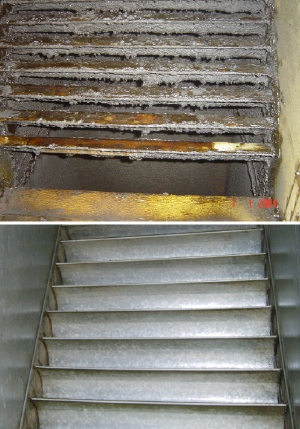How clean — and safe — is your ductwork

With B&ES having updated its 10-year-old guide on the internal cleanliness of ductwork systems in response to the introduction of a British and European standard, Richard Norman looks at the implications.
The Building & Engineering Services Association has recently updated the ‘Guide to good practice – internal cleanliness of ventilation systems’ (TR19). It is almost 10 years since the previous update, and in that time we have seen ever-more stringent levels of ventilation-system cleanliness being required.
There are two key factors driving this requirement.
• Increased awareness of and concern for internal air pollution and its impact on building occupants.
• Fire risk from grease build up in kitchen extract systems, which is linked to an alarming number of fires every year in non-domestic kitchens. In nine out of 10 fires linked to catering facilities, grease deposits in grease extract ducting have ignited to make fires more widespread and destructive.
Our objective in creating this second edition of the guide is to address these issues whilst aligning our UK industry standard more closely to the British and European Standard BS EN 15780 ‘Cleanliness of ventilation systems’, which was introduced in 2011. There are differences between the two standards, some significant, some subtle, making compliance more challenging for UK industry practitioners. As BS EN 15780 takes precedence over TR19, it is essential that our industry standard is kept up to date and reflects the contents of BS EN 15780.
The revised guide is intended for use in new-build installations, refurbishment system upgrades and planned maintenance of ventilation systems.
While we recommend review of the document in its entirety, I’d like to highlight the two main changes.
The first relates to air quality and ventilation ducting pre-clean testing methods. BS EN 15780 summarises the various types of test methods that give a quantitative measurement of dust deposits on duct surfaces, including the TR19 deposit thickness test (DTT) and vacuum test (VT), which have historically been used to evaluate the cleanliness of ventilation systems. However, BS EN 15780 introduces a new preferred vacuum test (PVT) in its test guidance notes, designed to measure the total amount of dust deposited in a duct. But the UK industry through TR19, has historically used deposit thickness testing (DTT) to give a similar measurement of total dust accumulation when evaluating duct cleanliness prior to cleaning and the vacuum test (VT) to validate cleanliness after duct cleaning.
The PVT testing protocol produces a measurement of the total impacted and loose dust and debris found in a duct. The VT only measures the loose dust that is released when the filter cartridge is passed over the template area, replicating normal airflows in ducting but resulting in impacted dust being left in the duct system. Testing has shown that residual or impacted dust is a latent source of microbial activity, and can contaminate air with harmful microorganisms.
Until now, neither document provided a comparison of PVT values (measured in grams) and DTT (measured in microns). We have added a reference table (Appendix F) that does this so that now practitioners using the DTT method can easily check that they are compliant with the requirements of BS EN 15780 when determining if a system needs to be cleaned, without the need to wait for laboratory analysis of the test filters (DTT giving and instant on-site test result). For post clean validation both BS EN 15780 and the new TR19 specify the PVT as the only test method.
 |
| Cleaning grease extract systems is a mandatory insurance requirement. |
In addition, BS EN 15780 defines buildings by classifications — ‘cleanliness quality classes’, and Section 2 of TR19 now includes a table showing typical applications of cleanliness quality classes.
BS EN 15780 describes in detail the requirements for cleanliness of newly installed duct systems. This has also been included in Appendix A of the updated TR19 guide.
The other significant change to TR19 is to section 7 — specific considerations for kitchen extract systems. The main change is in the recommendations for frequency of cleaning based on type of cooking and hours of usage. A new table provides clearer guidance to assist in assessing the requirements for cleaning, particularly where cooking methods produce high volumes of airborne grease contaminants.
It should be noted that commercial liability/property insurance policies invariably contain conditions and warranties that stipulate a minimum cleaning frequency for grease extract ductwork systems and canopy filters. While some may base their requirements on TR19 recommendations, we are seeing some insurers requiring a higher frequency of cleaning; failure to comply with such requirements will of course invalidate the building insurance policy, so it’s vital those responsible for management of the property are aware not only of TR19 recommendations but also their own insurer’s requirements and, of course, those of the Fire Safety Order by ensuring that their extraction system is regularly inspected between planned cleaning visits. (In addition, the canopy and canopy/extract plenum is an area of higher fire risk, and consideration should be given to more frequent cleaning in accordance with insurers’ requirements.)
In the UK, grease extract cleaning is larger by value than regular ventilation duct cleaning and likely to increase with the growing demands of insurers. However, there are currently no standards for grease extract cleaning in BS EN 15780. Clearly this is one area where the UK leads the way, but it’s another example of inconsistencies between the two standards and one which must be rectified.
BS EN 15870 is an ‘umbrella’ standard with informative annexes that can be revised and added, so we have the opportunity to correct this discrepancy, and we are now acting on behalf of the industry to have grease extract ductwork cleaning included. Indeed this move has already been agreed in principle by the British Standards Institute. I sit on the CEN Committee (European Committee for Standardisation), and we have been asked to provide a summary of TR19 section 7 to the committee for consideration for inclusion in BS EN 15780.
Earlier this year I was appointed chairman of the B&ES Ventilation Hygiene branch, and I’m delighted to have had the opportunity to be a part of the drive to raise our industry standards still further.
I intend to use the PR opportunity that the second edition of TR19 offers us to raise the standard’s profile and put the focus firmly on cleanliness in relation to health and safety matters.
It’s vital that all our stakeholders (cleaning companies, facilities managers and facilities management contactors and property owners/managers) are fully aware of their obligations to cleanliness of ductwork systems and make health and safety a priority.
Richard Norman is chairman of the Ventilation Hygiene branch of the Building & Engineering Services Association and managing director of Indepth Hygiene.








